Grackles can quickly become a significant nuisance when they congregate in large numbers, creating problems through excessive noise, property damage, and aggressive behavior toward other birds. While these intelligent native birds serve important ecological roles, their overwhelming presence can disrupt both residential and agricultural environments. This comprehensive guide provides effective, humane, and legal methods how to get rid of grackles and encourage them to relocate without causing harm.
Quick Picks: Best Grackle Deterrents
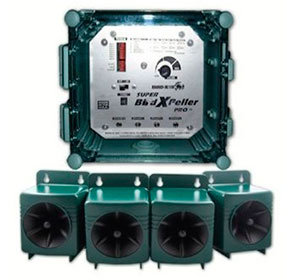
Best Audio Deterrent
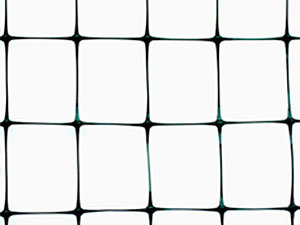
Best Physical Barrier
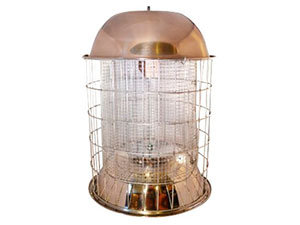
Best For Bird Lovers
- Understanding Grackles: Biology and Behavior
- Problems Caused by Grackles
- How to Get Rid of Grackles: 3 Effective Strategies
- Top Grackle-Proof Bird Feeders
- Legal Considerations for Grackle Control
- Creating an Integrated Grackle Management Plan
- Frequently Asked Questions
- Best Approach for Successful Grackle Control
Understanding Grackles: Biology and Behavior
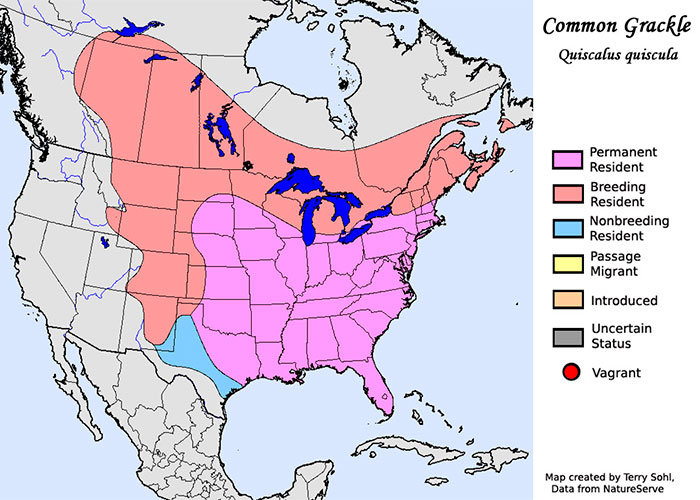
Distribution
Common grackles are primarily found in the eastern and southeastern United States, with particularly large populations in Texas and Florida. They may migrate seasonally but often maintain year-round presence in preferred habitats.
Identification
Adults measure 11-13 inches in length with iridescent black plumage that may show purple, green, or blue sheen in sunlight. Males are larger than females, with longer tails and more pronounced iridescence.
Intelligence
Grackles demonstrate remarkable problem-solving abilities, adaptability, and social learning. Their intelligence makes them challenging to deter using static methods, as they quickly become habituated to unchanging threats.
Grackle vs. Starling: Key Differences
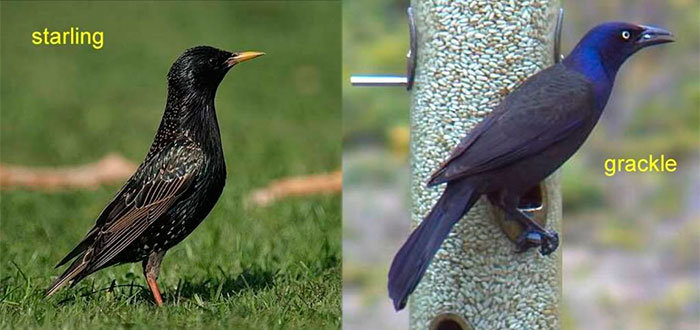
| Feature | Grackles | Starlings |
|---|---|---|
| Origin | Native to North America | Introduced species (non-native) |
| Size | Larger (11-13 inches) | Smaller (8-9 inches) |
| Appearance | Long legs, longer tail, golden eyes | Shorter legs, shorter tail, darker eyes |
| Bill | Longer, curved, heavy bill | Thin, long, pointed bill |
| Protection Status | Protected under Migratory Bird Treaty Act | Not protected (invasive species) |
Social Behavior and Flocking
Grackles are highly social birds that often gather in enormous flocks, particularly when roosting or feeding. According to the Cornell Lab of Ornithology, they frequently mix with other blackbirds, cowbirds, and starlings to form massive mixed-species flocks that can number in the thousands or even millions of individuals.
Grackles are protected under the Migratory Bird Treaty Act, making it illegal to kill, capture, or harm them without proper permits. All deterrent methods discussed in this guide are non-lethal and comply with federal wildlife protection laws.
Problems Caused by Grackles
Residential Issues
- Excessive noise, especially during dawn and dusk
- Aggressive behavior toward other birds
- Monopolizing bird feeders
- Droppings that can damage vehicles and property
- Potential disease transmission through droppings
Agricultural Impact
- Significant crop damage, especially to corn
- Consumption of both sprouting seeds and ripening crops
- Millions of dollars in agricultural losses annually
- Damage to fruit crops including berries and cherries
- Disruption of livestock feeding operations
Commercial Concerns
- Customer discomfort at outdoor dining areas
- Property maintenance costs from cleaning droppings
- Health code compliance issues for food service
- Corrosion of building materials from acidic droppings
- Noise disturbances at business locations
Research from Birds of the World indicates grackles are considered one of the “economically most significant pest species in North America” due to their impact on corn, blueberries, sweet cherries, and other agricultural products.
How to Get Rid of Grackles: 3 Effective Strategies
Successfully managing grackle problems requires a multi-faceted approach that targets their behavior from several angles. The most effective control programs combine multiple methods to create an environment that’s unwelcoming to these persistent birds.
Strategy 1: Physical Exclusion
Creating physical barriers is one of the most reliable methods to prevent grackles from accessing specific areas of your property. These solutions are particularly effective for protecting smaller areas like gardens, crops, and defined spaces.
Secure netting properly along all edges to prevent birds from finding entry points. For agricultural applications, support netting with a framework that keeps it elevated above crops to prevent birds from reaching through the material.
Bird-X Standard Protective Netting
Best Physical BarrierHow Does It Work
How to Use
- Measure the area requiring protection and select appropriate netting size
- Install using support poles, hooks, or other attachment points
- Secure all edges thoroughly to prevent birds from finding entry points
- Check periodically for damage and repair as needed
- 100% effective when properly installed
- Long-lasting and reusable for multiple seasons
- No habituation concerns - birds can't adapt to physical barriers
- Safe and humane with no negative environmental impact
- Requires proper installation and maintenance
- May be visually noticeable depending on application
- Not practical for extremely large areas like expansive fields
- Initial installation can be time-consuming
Strategy 2: Taste and Odor Deterrents
Taste aversion products make food sources unpalatable to grackles without harming them, creating an invisible layer of protection around plants, crops, and other vulnerable areas.
For maximum effectiveness, apply taste deterrents before grackles establish feeding patterns in the area. Once birds have identified a location as a reliable food source, they become more persistent and harder to discourage.
Bird-X Bird Stop Liquid Bird Repellent
Best Taste DeterrentHow Does It Work
How to Use
- Mix according to package directions in a sprayer
- Apply to crops, trees, shrubs, or other surfaces where grackles feed
- Reapply after heavy rain or as directed on the product label
- Use preventatively before birds establish feeding patterns
- Non-toxic and safe for use around people, pets, and wildlife
- Creates an invisible barrier with minimal visual impact
- Effective for protecting crops and landscaping
- Can be applied directly to food crops (follow label instructions)
- Requires reapplication after rain or irrigation
- May need multiple applications for persistent birds
- Less effective if birds are already habituated to the area
- Not suitable for extremely large areas due to application costs
Strategy 3: Audio and Visual Deterrents
Electronic and visual scare devices create an environment that appears threatening to grackles, exploiting their natural wariness of predators and danger.
Maximizing Electronic Deterrent Effectiveness
- Change the position and programming of devices regularly
- Use a combination of audio and visual deterrents simultaneously
- Deploy deterrents before grackles establish a presence
- Select Version 2 of BirdXPeller Pro specifically designed for grackles
- Place devices at different heights around the protected area
Bird-X BirdXPeller Pro Electronic Bird Repeller
Best Audio DeterrentHow Does It Work
How to Use
- Mount the unit 10-15 feet high with speakers facing the problem area
- Program for species-specific deterrence (Version 2 for grackles)
- Set volume appropriate to the coverage area needed
- Select random play modes to prevent habituation
- Reposition periodically to enhance effectiveness
- Covers up to 1 acre of open space
- Programmable for specific bird species
- Weather-resistant for outdoor use
- Multiple power options (AC adapter or battery)
- Customizable sound patterns and volume
- Some neighbors may find the sounds disruptive
- Requires power source (AC or batteries)
- Less effective in extremely noisy environments
- Birds may become habituated without periodic adjustments
Bird-X recommends that “due to the aggressive behavior of grackles, a multisensory approach using different types of products, like a visual deterrent along with a sonic repellent, is ideal” for effective control.
Top Grackle-Proof Bird Feeders
For bird enthusiasts who want to continue feeding smaller songbirds while deterring grackles, specialized feeders offer an effective solution.
Cage-Style Feeders
These feeders surround the seed tube with a wire cage that allows small birds to enter while blocking larger species like grackles. The small openings prevent grackles from reaching the food source while still accommodating chickadees, finches, and other desirable visitors.
Weight-Activated Feeders
These innovative feeders use the grackle’s weight against them. When a heavier bird lands on the perch, a mechanism closes access to the seed ports. Lighter songbirds can feed normally without triggering the closure mechanism.
RollerFeeder Technology
These specialized feeders feature rolling perches that large birds like grackles cannot stabilize on, preventing them from accessing the seed ports. Smaller birds can feed comfortably while grackles are effectively excluded.

Cage Design Bird Feeder
- Protective cage prevents large birds from reaching seed
- Multiple feeding ports for songbirds
- Simple yet effective design
- Ideal for mixed bird seed
- Durable construction for outdoor use
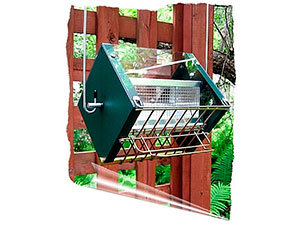
RollerFeeder
- Innovative rolling perch technology
- Destabilizes when heavier birds land
- Allows smaller songbirds to feed comfortably
- No moving parts to maintain
- Simple, elegant design
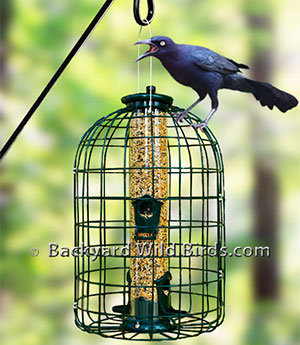
Caged Tube Feeder
- Surrounds seed tube with protective cage
- Small birds can enter, grackles cannot
- Decorative design enhances yard aesthetics
- Compatible with most bird feeder poles
- Four seed ports for multiple birds
Position feeders away from easily accessible perches and overhanging branches. Grackles prefer to survey an area before approaching, so limiting nearby landing spots can further discourage them from attempting to access feeders.
Legal Considerations for Grackle Control
Before implementing any grackle control methods, it’s essential to understand the legal protections these birds have under federal law.
According to the U.S. Fish and Wildlife Service, the Migratory Bird Treaty Act makes it “unlawful without a waiver to pursue, hunt, take, capture, kill, or sell” protected birds like grackles. All control methods must be non-lethal unless special permits are obtained.
All the deterrent methods outlined in this guide comply with federal wildlife protection laws and focus on humane approaches to behavior modification rather than lethal control. The goal is to discourage grackles from using specific areas by making them less attractive, not to harm the birds.
Creating an Integrated Grackle Management Plan
The most successful approach to grackle control involves combining multiple methods into a comprehensive strategy that addresses the specific challenges of your situation.
Step 1: Eliminate Attractants
- Remove or modify standard bird feeders that attract grackles
- Secure garbage containers with tight-fitting lids
- Clean up fallen fruit from trees and shrubs
- Store pet food indoors and feed pets inside when possible
- Eliminate standing water sources or make them inaccessible
Step 2: Implement Multiple Deterrent Types
- Install physical barriers (netting, wire) to protect high-value areas
- Apply taste aversion products where grackles feed
- Deploy electronic repellers programmed specifically for grackles
- Add visual deterrents like reflective tape or predator decoys
- Install specialized feeders if you wish to continue feeding other birds
Step 3: Monitor, Maintain, and Adapt
- Regularly reposition visual deterrents to prevent habituation
- Change electronic repeller settings periodically
- Reapply taste deterrents according to product instructions
- Inspect physical barriers for damage or entry points
- Observe grackle behavior and adjust strategy accordingly
Grackles are intelligent and adaptable birds that may test deterrents repeatedly. Maintaining and varying your approach is essential for long-term success. Most successful control programs require 2-3 weeks of consistent deterrent presence before grackles permanently change their behavior patterns.
Frequently Asked Questions
Are grackles protected by law?
Yes, grackles are protected under the federal Migratory Bird Treaty Act, which makes it illegal to kill, capture, or harm them without special permits from the U.S. Fish and Wildlife Service. All control methods must be non-lethal unless specific depredation permits are obtained, which are typically only granted in cases of significant agricultural damage.
While it’s legal to use deterrents that discourage grackles from specific areas, any method that could harm or kill the birds is prohibited. This includes trapping, poisoning, or shooting grackles, regardless of how problematic they may be.
What’s the best way to keep grackles away from bird feeders?
The most effective approach is to use specialized grackle-proof feeders designed to prevent larger birds from accessing the seed while allowing smaller songbirds to feed. These include:
- Cage-style feeders with openings too small for grackles
- Weight-activated feeders that close when heavy birds land
- RollerFeeder designs with unstable perches for larger birds
Additionally, changing your feeding strategy can help. Try offering foods that grackles don’t prefer, such as nyjer seed, safflower seed, or suet in specialized feeders. Removing platform feeders and ground feeding areas can also significantly reduce grackle activity.
How do I keep grackles away from my crops?
Protecting agricultural crops from grackles requires a multi-faceted approach:
- Physical Barriers: Bird netting provides complete exclusion for high-value crops
- Taste Deterrents: Apply bird repellent products containing methyl anthranilate to make crops unpalatable
- Sound Deterrents: Electronic devices broadcasting predator and distress calls can be effective for larger areas
- Visual Scarers: Reflective tape, predator decoys, and scare balloons provide additional deterrence
- Timing Adjustments: When possible, adjust planting schedules to avoid peak grackle activity periods
For maximum effectiveness, combine multiple methods and rotate visual deterrents regularly to prevent habituation.
Do ultrasonic bird repellers work on grackles?
Ultrasonic bird repellers have limited effectiveness against grackles for several reasons:
- Birds cannot hear frequencies as high as those claimed by many ultrasonic devices
- Sound waves from ultrasonic devices don’t travel far and are blocked by obstacles
- Birds quickly become habituated to constant ultrasonic sounds
- No scientific studies have demonstrated reliable effectiveness of ultrasonic-only devices for bird control
You’ll achieve better results with audible sound deterrents that use recorded distress calls and predator sounds, such as the BirdXPeller Pro, combined with visual deterrents and physical barriers.
How do I keep grackles from nesting in my trees?
To discourage grackles from nesting in your trees:
- Install visual deterrents in trees before nesting season begins (early spring)
- Use reflective tape, predator decoys, or scare balloons in the canopy
- Deploy audio deterrents that broadcast predator calls near potential nesting sites
- Prune trees to remove dense, protected areas where grackles prefer to nest
- Consider installing physical barriers like bird netting in extreme cases
Important: Once grackles have established nests with eggs or young, they are protected by federal law and cannot be disturbed without permits. Prevention is essential before nesting begins.
What natural predators keep grackle populations in check?
Grackles face predation from several natural enemies including:
- Birds of Prey: Hawks, falcons, and owls will hunt adult grackles
- Nest Predators: Crows, jays, raccoons, and snakes target eggs and nestlings
- Mammals: Foxes, bobcats, and domestic cats may catch grackles feeding on the ground
While these natural predators help control grackle populations in balanced ecosystems, they typically aren’t present in sufficient numbers in urban and suburban environments to significantly reduce large grackle flocks. This is one reason why grackles thrive in human-modified landscapes.
How long do grackle control methods take to work?
The timeline for effective grackle control varies depending on several factors:
- Immediate Results: Physical barriers like netting provide instant exclusion
- Short-Term Results (1-7 days): Electronic deterrents and taste aversions may show initial effects
- Medium-Term Results (1-3 weeks): Most combined deterrent strategies require consistent application
- Long-Term Success (3+ weeks): Permanent behavior modification typically takes several weeks
Grackles are intelligent birds that may test deterrents repeatedly. Success depends on consistency, using multiple methods simultaneously, and regularly changing visual and audio deterrents to prevent habituation. Most successful programs see significant results within 2-3 weeks when properly implemented.
Best Approach for Successful Grackle Control
The most effective strategy how to get rid of grackles combines multiple deterrent methods that target different senses and behaviors. This integrated approach creates an environment that grackles find consistently unwelcoming, encouraging them to relocate to more hospitable areas while allowing you to maintain an environment that’s friendly to desirable bird species. Some effective methods include using visual deterrents, such as reflective surfaces or decoy predators, to disrupt their comfort level. Additionally, auditory repellents or habitat management can be employed to minimize attractants and nesting opportunities. For those dealing with other bird species, such as swallows, understanding how to permanently remove swallows requires a different set of strategies tailored to their specific nesting behaviors and preferences.
Key principles for successful grackle management include:
- Early Intervention: Deploy deterrents before grackles establish regular feeding or nesting patterns in your area
- Multiple Methods: Combine visual, auditory, taste, and physical barriers for maximum effectiveness
- Consistent Application: Maintain deterrents continuously to prevent birds from testing and overcoming them
- Regular Variation: Change the position and settings of deterrents to prevent habituation
- Patience and Persistence: Allow sufficient time for grackles to learn to avoid the area
By implementing these strategies with high-quality deterrent products, you can effectively manage grackle problems while respecting wildlife protection laws and maintaining an ethical approach to bird control.
Despite their nuisance status in certain contexts, grackles play important ecological roles in controlling insect populations and contributing to biodiversity. The goal of ethical management is to redirect their activities away from problem areas rather than eliminating these native birds from the ecosystem entirely.
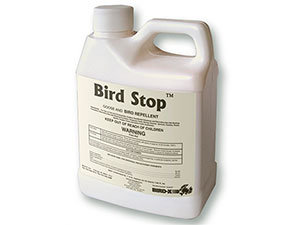
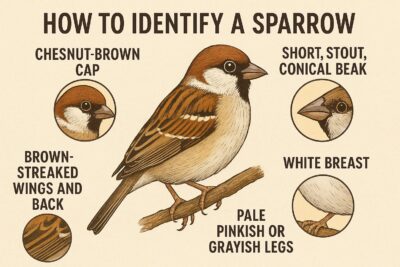



Hi
I TRIED SCREAM FLY OFF MY TREES 12 COMMON GRACKEL BIRDS
CLAPING NOT WORKING GET GRACKEL BIRS OFF MY TREES OUTSIDE MY YARD
HOPE YOU CAN HELP US TWO THANKS HAVE A NICE DAY
Nancy – maybe if you spell GRACKLE correctly, clapping and screaming will work better. They may not understand that spelling. They’re smart, but not that smart.
In the past 5 years I’ve had two really dumb neighbors who apparently caught on and stopped feeding the grackles, however it’s too late. I don’t see any beautiful birds anymore and all they do is squawk, shit, and dive-bomb me and my cat. It really is depressing because I live in a neighborhood where some butt-hole neighbor will be too quick to call the police for shooting these “kazarian mafia” pests.
Most of these methods are BS! I’ve tried them!
I have been using firecrackers for the past few years. They make my neighbors a little nuts, and the barking dogs, but are very effective. Some times I loose the fight, but I am definitely winning the war. I have cut down thousands of piles of bird feces, to maybe 50 a season. My dog actually gets excited when she sees me reach for the firecrackers to get rid of “the bad birds”. I have shared with all my neighbors on my block with pools. Good luck to all.
Linda, I’m on a new property where I just shot a grackle with my scoped long-range pellet rifle. The entire flock became frenzied with fear then flew far away. It’s very quiet now and I don’t expect them to return. This is how I controlled a particularly nasty crow population at my last residence. It’s the tried and true methods that yield quick and thorough results, and shooting a pellet up into a tree will not endanger your neighbors.
how do I keep them from dive bombing and attacking my dog. I have an elderly English Springer Spaniel and they have actually ripped fur from his back.
Grackles appear on our property every late March and early June. They build nests in our stands of arborvitae and begin hatching their young in late April and early May, consequently they clean the feces ,etc from their nets from the young birds and drop it on 1 specific area , our back patio. We have tried plastic owls, spinners and other devices, the only thing that seems to work to a small degree is balloons tied to various objects on our patio. We own 1 1/2 acres so they could easily drop all the bird dirt from the nests on the ground but they prefer to dive bomb our patio and drop all of it there, this continues for over a month and they they migrate somewhere else. Any suggestions???
We have the same problem. the only thing that has worked is shooting one and laying it out by the patio/pool…about 2-4 yards away.
Hi
we can understand why common grackle birds not leaving your trees your yard too
we have 13 common grackle birds our outside our yard bad to have too
Hi
Me and My MOM We Can Understand Why Black Common Grackle Birds Won’t
Leave Your Yard Too
I Tired Screaming FLy Far Away Black Common Grackle Birds
We have so many grackles.They are even getting into my little bluebird feeder.They empty the meal worms in a few minutes. Thinking of shooting them for the feral cats. Help
Do you know if the Bird XPeller Pro repels grackles but not robins? I am looking for a solution that repells grackles, but I don’t want to frighten away the robins that are nesting in our backyard.
Hello Inga,
Thanks for your insight. I have a squirrel proof bird feeder but it’s accessible by grackles. I wonder if I put an add-on roofs above the perches to make it a low clearance will help.
Thank you,
Joe
Why am I seeing Grackles eat safflower, which they supposedly don’t like?